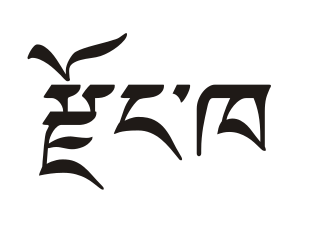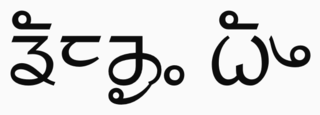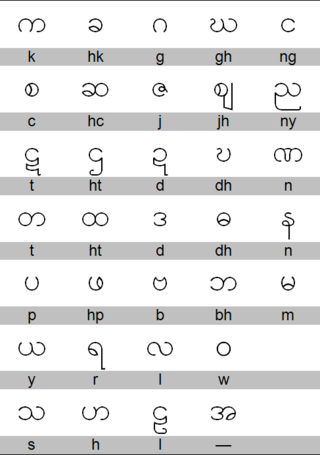
Chinese is a group of languages spoken natively by the ethnic Han Chinese majority and many minority ethnic groups in China. Approximately 1.35 billion people, or 17% of the global population, speak a variety of Chinese as their first language.

The Tibetic languages form a well-defined group of languages descending from Old Tibetan. According to Nicolas Tournadre, there are 50 Tibetic languages, which branch into more than 200 dialects, which could be grouped into eight dialect continua. These Tibetic languages are spoken in Tibet, the greater Tibetan Plateau, and in the Himalayas in Gilgit-Baltistan, Ladakh, Aksai Chin, Nepal, and in India at Himachal Pradesh, and Uttarakhand. Classical Tibetan is the major literary language, particularly for its use in Tibetan Buddhist scriptures and literature.

The Tibetan script is a segmental writing system, or abugida, derived from of Brahmic scripts and Gupta script, and used to write certain Tibetic languages, including Tibetan, Dzongkha, Sikkimese, Ladakhi, Jirel and Balti. It was originally developed c. 620 by Tibetan minister Thonmi Sambhota for King Songsten Gampo.

A sacred language, holy language or liturgical language is a language that is cultivated and used primarily for religious reasons by people who speak another, primary language in their daily lives.

Dzongkha is a Tibeto-Burman language that is the official and national language of Bhutan. It is written using the Tibetan script.

Wylie transliteration is a method for transliterating Tibetan script using only the letters available on a typical English-language typewriter. The system is named for the American scholar Turrell V. Wylie, who created the system and published it in a 1959 Harvard Journal of Asiatic Studies article. It has subsequently become a standard transliteration scheme in Tibetan studies, especially in the United States.
Literary language is the form (register) of a language used when writing in a formal, academic, or particularly polite tone; when speaking or writing in such a tone, it can also be known as formal language. It may be the standardized variety of a language. It can sometimes differ noticeably from the various spoken lects, but the difference between literary and non-literary forms is greater in some languages than in others. If there is a strong divergence between a written form and the spoken vernacular, the language is said to exhibit diglossia.
The Ladakhi language is a Tibetic language spoken in the Indian union territory of Ladakh. It is the predominant language in the Buddhist-dominated district of Leh, and a minority language in the district of Kargil. Though a member of the Tibetic family, Ladakhi is not mutually intelligible with Standard Tibetan. Ladakhis and Tibetans usually communicate with each other in Hindi or English as they do not understand each other's languages clearly.
Tshangla is a Sino-Tibetan language of the Bodish branch closely related to the Tibetic languages. Tshangla is primarily spoken in Eastern Bhutan and acts as a lingua franca in the region; it is also spoken in the adjoining Tawang tract in the Indian state of Arunachal Pradesh and the Pemako region of Tibet. Tshangla is the principal pre-Tibetan language of Bhutan.
Khams Tibetan is the Tibetic language used by the majority of the people in Kham. Khams is one of the three branches of the traditional classification of Tibetic languages. In terms of mutual intelligibility, Khams could communicate at a basic level with the Ü-Tsang branch.

Limbu is a Sino-Tibetan language spoken by the Limbu people of Nepal and Northeastern India as well as expatriate communities in Bhutan. The Limbu refer to themselves as Yakthung and their language as Yakthungpan. Yakthungpan has four main dialects: Phedape, Chhathare, Tambarkhole and Panthare dialects.
Sikkimese(Tibetan: འབྲས་ལྗོངས་སྐད་, Wylie: 'bras ljongs skad, THL: dren jong ké, "rice valley language") is a language of the Tibeto-Burman languages spoken by the Bhutia people in Sikkim, India, and in parts of Koshi, Nepal. It is one of the official languages of Sikkim.

Lhasa Tibetan or Standard Tibetan is the Tibetan dialect spoken by educated people of Lhasa, the capital of the Tibetan Autonomous Region. It is an official language of the Tibet Autonomous Region.

There are approximately a hundred languages spoken in Myanmar. Burmese, spoken by two-thirds of the population, is the official language.

The Gyalrongic languages constitute a branch of the Qiangic languages of Sino-Tibetan, but some propose that it may be part of a larger Rung languages group and do not consider it to be particularly closely related to Qiangic but suggest that similarities between Gyalrongic and Qiangic may be from areal influence. However, other work suggests that Qiangic as a whole may in fact be paraphyletic, with the only commonalities of the supposed "branch" being shared archaisms and areal features that were encouraged by language contact. Jacques & Michaud (2011) propose that Qiangic including Gyalrongic may belong to a larger Burmo-Qiangic group based on some lexical innovations.
This page is based on this
Wikipedia article Text is available under the
CC BY-SA 4.0 license; additional terms may apply.
Images, videos and audio are available under their respective licenses.









